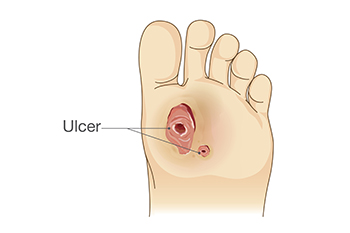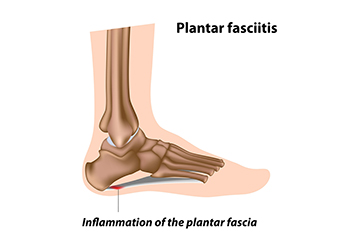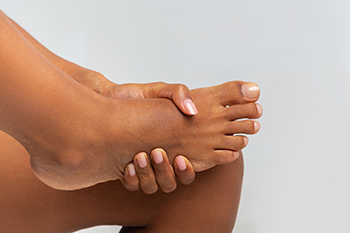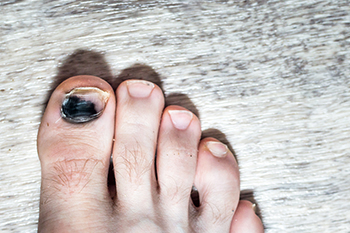December 2023
Different Types of Diabetic Foot Ulcers

Diabetic foot ulcers, a major complication for individuals with diabetes, vary based on depth, infection, and location. They are primarily categorized into neuropathic, ischemic, and neuroischemic ulcers. Neuropathic ulcers occur due to nerve damage, resulting in loss of sensation in the feet. Patients may not feel minor injuries, leading to ulcers, generally located under the foot's high-pressure areas. Ischemic ulcers stem from poor blood circulation, often associated with peripheral arterial disease. They can appear anywhere on the foot but are typically found in areas with poor blood supply. Neuroischemic ulcers combine the features of both neuropathic and ischemic ulcers, presenting a blend of circulation issues and nerve damage. These are the most common and challenging to treat, as they are prone to infection and slow healing. If you are diabetic and have foot problems, it is strongly suggested that you schedule regular appointments with a podiatrist to have your feet properly examined and ensure that any brewing issues, such as foot ulcers, are treated promptly.
Diabetic foot care is important in preventing foot ailments such as ulcers. If you are suffering from diabetes or have any other concerns about your feet, contact John Killough, DPM from Regional Foot Center. Our doctor can provide the care you need to keep you pain-free and on your feet.
Diabetic Foot Care
Diabetes affects millions of people every year. The condition can damage blood vessels in many parts of the body, especially the feet. Because of this, taking care of your feet is essential if you have diabetes, and having a podiatrist help monitor your foot health is highly recommended.
The Importance of Caring for Your Feet
- Routinely inspect your feet for bruises or sores.
- Wear socks that fit your feet comfortably.
- Wear comfortable shoes that provide adequate support.
Patients with diabetes should have their doctor monitor their blood levels, as blood sugar levels play such a huge role in diabetic care. Monitoring these levels on a regular basis is highly advised.
It is always best to inform your healthcare professional of any concerns you may have regarding your feet, especially for diabetic patients. Early treatment and routine foot examinations are keys to maintaining proper health, especially because severe complications can arise if proper treatment is not applied.
If you have any questions please feel free to contact our offices located in Charleston and Effingham, IL . We offer the newest diagnostic and treatment technologies for all your foot and ankle needs.
Definition and Risk Factors Explored for Plantar Fasciitis

Plantar fasciitis, a prevalent foot condition, unfolds as inflammation of the plantar fascia, which is the thick band of tissue connecting the heel bone to the toes. This inflammation results in stabbing pain, typically most pronounced during the first steps in the morning or after periods of inactivity. The plantar fascia plays an important role in supporting the foot's arch and absorbing shock during walking. Several risk factors contribute to the development of plantar fasciitis. Prolonged periods of standing or walking on hard surfaces can strain the plantar fascia, increasing susceptibility. Individuals with high arches or flat feet may experience altered weight distribution, intensifying stress on the foot's support structure. Additionally, having tight calf muscles and Achilles tendons may also heighten the risk, limiting ankle flexibility. Understanding the definition and associated risk factors of plantar fasciitis is vital for proactive management. If you have heel pain, it is strongly suggested that you seek the counsel of a podiatrist who can offer treatment options for this painful condition.
Plantar fasciitis is a common foot condition that is often caused by a strain injury. If you are experiencing heel pain or symptoms of plantar fasciitis, contact John Killough, DPM from Regional Foot Center. Our doctor can provide the care you need to keep you pain-free and on your feet.
What Is Plantar Fasciitis?
Plantar fasciitis is one of the most common causes of heel pain. The plantar fascia is a ligament that connects your heel to the front of your foot. When this ligament becomes inflamed, plantar fasciitis is the result. If you have plantar fasciitis you will have a stabbing pain that usually occurs with your first steps in the morning. As the day progresses and you walk around more, this pain will start to disappear, but it will return after long periods of standing or sitting.
What Causes Plantar Fasciitis?
- Excessive running
- Having high arches in your feet
- Other foot issues such as flat feet
- Pregnancy (due to the sudden weight gain)
- Being on your feet very often
There are some risk factors that may make you more likely to develop plantar fasciitis compared to others. The condition most commonly affects adults between the ages of 40 and 60. It also tends to affect people who are obese because the extra pounds result in extra stress being placed on the plantar fascia.
Prevention
- Take good care of your feet – Wear shoes that have good arch support and heel cushioning.
- Maintain a healthy weight
- If you are a runner, alternate running with other sports that won’t cause heel pain
There are a variety of treatment options available for plantar fasciitis along with the pain that accompanies it. Additionally, physical therapy is a very important component in the treatment process. It is important that you meet with your podiatrist to determine which treatment option is best for you.
If you have any questions, please feel free to contact our offices located in Charleston and Effingham, IL . We offer the newest diagnostic and treatment technologies for all your foot care needs.
Dealing With Foot Pain

Foot pain can stem from a myriad of causes, each intricately tied to the complex structure of the foot. One prevalent contributor is improper footwear, as shoes with an ill fit or high heels can induce foot pain and disorders. The foot, supporting the body's weight, is susceptible to injuries during high-impact activities like running or aerobics. These activities can lead to ligament sprains, muscle or tendon strains, and foot bone fractures. Degenerative conditions such as osteoarthritis and rheumatoid arthritis may also play a role in foot pain. Osteoarthritis arises from cartilage overuse around joints, commonly affecting the big toe, ankle, and midfoot. Meanwhile, rheumatoid arthritis introduces pain, stiffness, swelling, soreness, and warmth in the foot and ankle joints. Diabetes, with its repercussions like nerve damage, reduced blood flow, and ulcers, often contributes significantly to foot pain. Numerous other conditions further complicate foot health, including plantar fasciitis and Achilles’ tendonitis. Corns, calluses, bunions, and plantar warts are other sources of foot pain. Ingrown toenails, Morton’s neuroma, and hammertoes may induce pain in parts of the foot. Peripheral arterial disease, gout, and flat feet are still other conditions that generate foot pain. If you experience any type of foot pain that persists or gets worse, it is suggested that you make an appointment with a podiatrist.
Foot Pain
Foot pain can be extremely painful and debilitating. If you have a foot pain, consult with John Killough, DPM from Regional Foot Center. Our doctor will assess your condition and provide you with quality foot and ankle treatment.
Causes
Foot pain is a very broad condition that could be caused by one or more ailments. The most common include:
- Bunions
- Hammertoes
- Plantar Fasciitis
- Bone Spurs
- Corns
- Tarsal Tunnel Syndrome
- Ingrown Toenails
- Arthritis (such as Gout, Rheumatoid, and Osteoarthritis)
- Flat Feet
- Injury (from stress fractures, broken toe, foot, ankle, Achilles tendon ruptures, and sprains)
- And more
Diagnosis
To figure out the cause of foot pain, podiatrists utilize several different methods. This can range from simple visual inspections and sensation tests to X-rays and MRI scans. Prior medical history, family medical history, and any recent physical traumatic events will all be taken into consideration for a proper diagnosis.
Treatment
Treatment depends upon the cause of the foot pain. Whether it is resting, staying off the foot, or having surgery; podiatrists have a number of treatment options available for foot pain.
If you have any questions, please feel free to contact our offices located in Charleston and Effingham, IL . We offer the newest diagnostic and treatment technologies for all your foot care needs.
Causes and Treatment of Black Toenail

A toenail turning black could be more than just a cosmetic concern. Discoloration, particularly a black toenail, is often a sign of an underlying issue that may require attention. One of the primary reasons for a black toenail is a bruise beneath the nail caused by trauma or pressure, also called a subungual hematoma. This common occurrence can result from stubbing your toe or dropping a heavy object on it. It also is common among runners as a result of the repetitive impact of the toenail against the front of the shoe. Shoes that are too tight or poorly fitting may create friction, causing damage to the nail and leading to subungual hematomas. Further, fungal nail infections, particularly in individuals with compromised immune systems, diabetes, or vascular disease, can cause toenail discoloration. These infections thrive in moist environments, making sweaty feet more susceptible. Ingrown toenails, a painful condition where the nail grows into the surrounding skin, can also cause discoloration. This may lead to bacterial infections, contributing to the darkening of the nail. In rare cases, a black toenail may be a sign of subungual melanoma, a type of skin cancer. Although uncommon, it is essential to seek medical attention if you notice persistent discoloration that is not linked to trauma or fungal infections. Certain medications can lead to toenail discoloration, including cancer drugs, antibiotics, retinoids, and drugs used to treat autoimmune conditions. If you have noticed your toenail changing in color, it is suggested that you make an appointment with a podiatrist who can determine the cause, and offer treatment options.
Toe pain can disrupt your daily activities. If you have any concerns, contact John Killough, DPM of Regional Foot Center. Our doctor can provide the care you need to keep you pain-free and on your feet.
What Causes Toe Pain?
Most severe toe pain is caused due to a sports injury, trauma from dropping something heavy on the toe, or bumping into something rigid. Other problems can develop over time for various reasons.
Toe pain can be caused by one or more ailments. The most common include:
- Trauma
- Sports injury
- Wearing shoes that are too tight
- Arthritis
- Gout
- Corns and calluses
- Hammertoe
- Bunions
- Blisters
- Ingrown toenails
- Sprains
- Fractures (broken bones)
- Dislocations
When to See a Podiatrist
- Severe pain
- Persistent pain that lasts more than a week
- Signs of infection
- Continued swelling
- Pain that prevents walking
Diagnosis
In many cases the cause of toe pain is obvious, but in others, a podiatrist may want to use more advanced methods to determine the problem. These can range from simple visual inspections and sensation tests to X-rays and MRI scans. Prior medical history, family medical history, and any recent physical traumatic events will all be taken into consideration for a proper diagnosis.
Treatment
Treatments for toe pain and injuries vary and may include shoe inserts, padding, taping, medicines, injections, and in some cases, surgery. If you believe that you have broken a toe, please see a podiatrist as soon as possible.
If you have any questions please feel free to contact our offices located in Charleston and Effingham, IL . We offer the newest diagnostic tools and technology to treat your foot and ankle needs.





